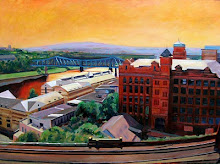
We couldn't work out what it might be used for. There were no roads to reach it, it was too uneven for anything other than maybe a helicopter landing field. But no helicopter would land where there were no roads or even decent paths. At one side (on the left in the photograph) was a concrete drain to take away surface water from the concrete field. The drain was blocked and the filed was obviously abandoned long ago, trees and shrubs thrusting up between the huge concrete slabs. What was it for? We were at a loss, although wandering through it gave a distinct sense of modern archaeology.
As we were about to leave, a man pushed through the bushes at the edge of the field and strode off to the other end. It looked as if he'd gone out at the other end , although we'd been unable to find another path at that end. We decided to follow him, but as we approached ht other end of the concrete field, he came back onto it. He nodded as he went by, so Pat asked if there was a path. He said there was but it wasn't good underfoot and made to stride off again (I think he was power-walking, actually). Before he went, Pat - ever the pro-active one - asked what the field was for. In halting English he explained: when it rained heavily the water would collect on the concrete and be led away through the drain to the town below.
What a great idea. And a lesson in lateral thinking. The drain wasn't a by-product of the field, put there to deal with the consequence of water collecting on the concrete, but an integral part of a water-collection system.












No comments:
Post a Comment